Hundreds of tourists settle in Damghan’s ecolodges during spring

TEHRAN – Damghan county ecolodges have played hostess to hundreds of domestic and overseas tourists since the very first day of this Persian year (started on March 20).
“More than 1200 tourists have stayed in ecolodges across the county,” Damghan’s official in charge of tourism told Mehr News Agency, highlighting that tens of the travelers were international guests, hailing from different nations such as France, Italia, and Netherlands, to name a few.
12 ecolodges, Mojtaba Akbarpour explained, are active within Damghan, and three other amenities are expected to open doors before this Persian year is out.
The official also stated that ecolodges are being established with the aim of strengthening hospitality infrastructure, reviving local culture, customs, and traditions, boosting the local economy, and acquainting tourists with lesser-known historical and natural attractions in rural areas.
“The revival of ecolodges in line with local characteristics in this area leads to increased employment, prevents migration, and encourages villagers to continue living in the village,” he further noted.
Abundant with remnants of the past caravanserais, strongholds, brick towers, edifices, and places of worship, Damghan can hardly be overlooked by a cultural tourist.
Situated some 350 km east of Tehran, Damghan has long been a giant hub for the culmination of pistachio sometimes referred to as “happy nuts” because they look like they’re smiling.
Narratives say the city’s name is derived from ‘Moghan’, which in Persian refers to practitioners of ‘magos’, or magic, and includes astrology, alchemy, and other forms of esoteric knowledge. In fact, the city was initially called ‘Dah Moghan’, meaning ten magi, which ultimately evolved to its current name Damghan.
For history buffs and researchers, Damghan is a gateway to Hecatompylos, which was the site of the Parthian capital during the ascendancy of the Arsacid of Media dynasty after the capture of the city by Alexander the Great.
Moreover, it was an important trading post of the Silk Roads, on the way from Merv to the Mediterranean coast, according to the book International Dictionary of Historic Places.
Damghan’s travel destinations include Tepe Hessar, old city Fortification, Tarikhaneh Mosque, Seljuk-era architectural gems, Chehel-Dokhtaran, Ismaili fortresses, Cheshmeh-Ali, along with some natural gems.
XF/AM
Leave a Comment